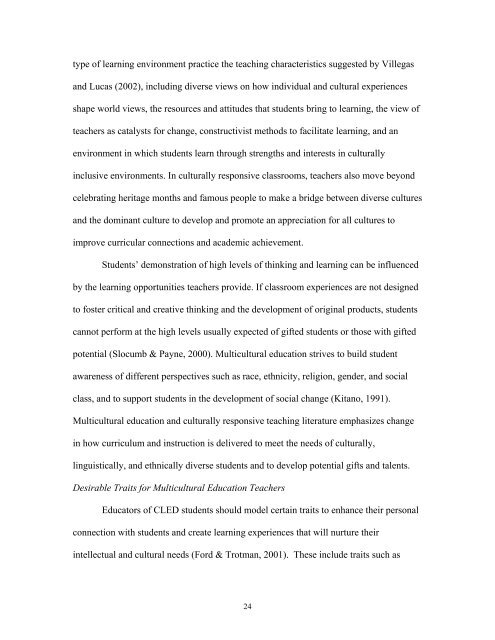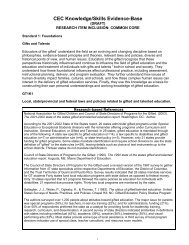Chapter One An Introduction to the Topic of Cultural Diversity - NAGC
Chapter One An Introduction to the Topic of Cultural Diversity - NAGC
Chapter One An Introduction to the Topic of Cultural Diversity - NAGC
You also want an ePaper? Increase the reach of your titles
YUMPU automatically turns print PDFs into web optimized ePapers that Google loves.
type <strong>of</strong> learning environment practice <strong>the</strong> teaching characteristics suggested by Villegas<br />
and Lucas (2002), including diverse views on how individual and cultural experiences<br />
shape world views, <strong>the</strong> resources and attitudes that students bring <strong>to</strong> learning, <strong>the</strong> view <strong>of</strong><br />
teachers as catalysts for change, constructivist methods <strong>to</strong> facilitate learning, and an<br />
environment in which students learn through strengths and interests in culturally<br />
inclusive environments. In culturally responsive classrooms, teachers also move beyond<br />
celebrating heritage months and famous people <strong>to</strong> make a bridge between diverse cultures<br />
and <strong>the</strong> dominant culture <strong>to</strong> develop and promote an appreciation for all cultures <strong>to</strong><br />
improve curricular connections and academic achievement.<br />
Students’ demonstration <strong>of</strong> high levels <strong>of</strong> thinking and learning can be influenced<br />
by <strong>the</strong> learning opportunities teachers provide. If classroom experiences are not designed<br />
<strong>to</strong> foster critical and creative thinking and <strong>the</strong> development <strong>of</strong> original products, students<br />
cannot perform at <strong>the</strong> high levels usually expected <strong>of</strong> gifted students or those with gifted<br />
potential (Slocumb & Payne, 2000). Multicultural education strives <strong>to</strong> build student<br />
awareness <strong>of</strong> different perspectives such as race, ethnicity, religion, gender, and social<br />
class, and <strong>to</strong> support students in <strong>the</strong> development <strong>of</strong> social change (Kitano, 1991).<br />
Multicultural education and culturally responsive teaching literature emphasizes change<br />
in how curriculum and instruction is delivered <strong>to</strong> meet <strong>the</strong> needs <strong>of</strong> culturally,<br />
linguistically, and ethnically diverse students and <strong>to</strong> develop potential gifts and talents.<br />
Desirable Traits for Multicultural Education Teachers<br />
Educa<strong>to</strong>rs <strong>of</strong> CLED students should model certain traits <strong>to</strong> enhance <strong>the</strong>ir personal<br />
connection with students and create learning experiences that will nurture <strong>the</strong>ir<br />
intellectual and cultural needs (Ford & Trotman, 2001). These include traits such as<br />
24

















